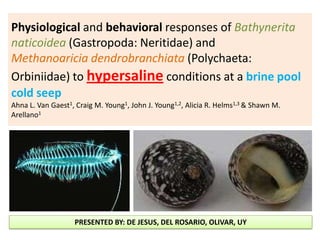
122 journal reporting
- 1. Physiological and behavioral responses of Bathynerita naticoidea (Gastropoda: Neritidae) and Methanoaricia dendrobranchiata (Polychaeta: Orbiniidae) to hypersaline conditions at a brine pool cold seep Ahna L. Van Gaest1, Craig M. Young1, John J. Young1,2, Alicia R. Helms1,3 & Shawn M. Arellano1 PRESENTED BY: DE JESUS, DEL ROSARIO, OLIVAR, UY
- 2. INNER ZONE: Bathynerita naticoidea are abundant High Methane and High Oxygen Concentrations High salinity BRINE POOL SURROUNDED BY MUSSEL BED I Bathymodiolus childressi O OUTER ZONE: Methanoaricia dendrobranchiata are abundant Low Oxygen Concentration SALINITY OF BRINE POOL: Low salinity 121.35 ~ 120
- 3. INQUIRY Under experimental conditions, which between the two differently distributed species (Bathynerita naticoidea: outer; Methanoaricia dendrobranchiata: inner) in a brine pool can tolerate higher salinities?
- 5. EXPERIMENT Legend Incubating Medium of Different salinities Individuals Salinities: 35, 45, 55, 65, 75 85 Incubation time: 15 hours
- 6. EXPERIMENT VS Salinities: 35, 55, 75,
- 7. EXPERIMENT Salinity 75 Weight Initial Weight every hour 6hr incubation
- 8. RESULTS 120 100 Percent Survival 80 60 40 20 0 35 45 55 65 75 85 Salinities B. naticoidea M. dendrobranchiata
- 10. RESULTS BEHAVIOURAL MECHANISMS THAT ALLOWED SURVIVAL IN THEIR SPECIFIC HABITATS Bathynerita naticoidea Methanoaricia dendrobranchiata Tight closing of the operculum Exists in large clumps to spread (seen in salinities 65-85) their collective surface area across the tops of the mussels in such a way to remain out of the Avoid entering salinities higher brine than 60 (confirmed by halocline experiment done by authors)
- 11. CONCLUSION • B. naticoidea was found to have higher salinity tolerance compared to M. dendrobranchiata • Salinity tolerances do not explain the differences in the distribution of the 2 organisms • Behavior is a likely mechanism for controlling horizontal distribution of this species across the mussel bed.
- 12. THANK YOU FOR LISTENING! AND REMEMBER BEHAVIOUR IS PHYSIOLOGICALLY IMPORTANT!
Editor's Notes
- Key words:In Gulf of Mexico na sea water may two abundant invertebrate species:Bathynerita – outer part -> high methane and low oxygen + high hydrogen sulfideMethanoaricia – inner part adjacent to brine pool -> high methane and oxygen + low hydrogen sulfidePhysiological response – automatic, instinctive and unlearned reaction to stimulusBehavioral response – attitude of the animal to stimuliCold Seep – higher temperature; formed in sea water. One type is brine pool others can be mud volcano and oil seepsBrine Pool – Hypersaline; three to five times greater than the surrounding oceanHalocline - subtype of chemocline caused by a strong, vertical salinity gradient within a body of water. Because salinity (in concert withtemperature) affects the density of seawater, it can play a role in its vertical stratification. Increasing salinity by one kg/m3 results in an increase of seawater density of around 0.7 kg/m3.
- B. Naticoidea salinity of 65 appeared stressed, often lying upside down with the operculum open
- B. Naticoidea salinity of 65 appeared stressed, often lying upside down with the operculum open
- B. Naticoidea salinity of 65 appeared stressed, often lying upside down with the operculum open
